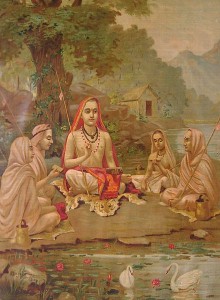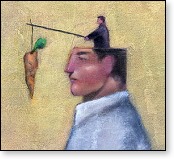 (Picture from Ada Shankara wiki)
(Picture from Ada Shankara wiki)
The retreat in swami Dayanada Saraswati’s ashram, and especially the lectures given by two swaminis and even one (once) by a Kolkota swami, brought up a lot of resistance in me.
And not only in me. I have seldom been in a group where the frustration was so widespread during the first days.
My impression was that for most people this emotions had faded away after the first week or so.
The resistance in me was strong. So strong that I decided to avoid those teachings. Being ill for almost a week after day 4 helped giving me an alibi. And by the time I was healthy again, I had decided to stick to my decision. Meanwhile thinking about, contemplating upon and inquiring into my inner movements got priority.
As mentioned before, the morning meditation made my day. I spoke about this meditation to someone as: for me it is advaita vedanta the non violent version.
By now it is already three month ago that this retreat happened. And two and a half month ago that I announced to write this part 2 as a follow up to part 1.
I made quite some notes two month ago and since I have thought about the subject a lot.
By now it is rather clear to myself what it is that I want to communicate.
And it would take me a year to write a essay about it. Yet this will not happen. Also it is about time to get this one done. In one way it seems to me rather stupid that I have to write this. On the other hand it keeps feeling as important enough to go on.
And what the heck, it’s my website after all.
I will give a summary, or some hints in the direction of what I want to express, without much referencing to sources.
Just like giving a informal speech. After that I will add my notes, just to get rid of them and for the happy few that likes to read them.
There we go:
The whole atmosphere in this ashram, not soothed by the shining presence of the main character, was (Beware: my experience is described here, nothing else) one of keeping in accordance with ancient traditions. Giving me the feeling that when you do not speak and read Sanskrit, you’ll never get it. (You’ll never get IT). And the idea that, in order to get to the point of Enlightenment, you have to go through a vast amount of knowledge, and to get the basics of that you have to attend a three year course with swami Dayananda Saraswati. This translated in a for me feelable level of fear (of not getting it) and restless being in a hurry.
My experience has been that the main seeing that all is one happened overnight after walking into the satsang of the guy that I basicly stayed with since the last 15 years or so.
It is clear for me that my experience there was strongly coloured by comparison with retreats with this guy (Isaac Shapiro).
It was a kind of anger toward the underlying axioms in the retreat with Dayananda’s swami’s and swamini’s: it is difficult, it hardly can be expressed in plain English, it will take a lot of time and you have to be damn lucky. I agree with the last one. And while it can tage ages before luck hits us, in a way any educational mode will do to pass the time in between. But why the F* taking a teaching model that is from the Middle Ages, at least.
Example: when someone asked a question about the text that was being explained, it happened that the swamini that was teaching counted on her fingers and said as from coming wednesday will be the time to ask questions. (Unspoken underlying old rule: the Guru explains a Upanishad and only after he is fully done with it, the disciple is allowed to ask questions)).
Once, some days too late, we finally got the printed text that was being explained. After distibuting them, there appeared to be not enough. On request of the swamini I gave mine to someone else, we could share booklet for the time being, and she promise to bring soem extra texts the next morging. The next morning, after she just had started her explaining, I raised my finger in order to ask for a textbooklet. She saw me doing it, and said to the whole group: people who have questions can come to my office this afternoon. After a while, when I thought it was a good non disturbing moment, I raised my finger again, cause I considered her answer not adequate and felt also old enough to decide that my question was appropriiate at that time. I was ignored. This for me, sorry ma’am, is not a situation that feels good enough to me.
So it is clearly a matter of a personal preference to a teaching style.
I myself prefer finding the here and now first and after that cleaning up the mess that appears to have clodded our nervous systems.
Instead of setting the seeing as a far ahead goal and not so much attention for the problems now, as they will (that seems to be the promised heaven in Hinduism) disappear like the unknown snow in the Sun.
A few days ago a swami that I met in Varanasi last Februari, visited me on my houseboat in Amsterdam. He stayed on walking distance two corners away from here.
When I told him about having to finish writing this, he became upset about what I told him. About this three year course by a guru. He stated that a real guru only takes one person as a sannyasin. More is not allowed and it is in the scriptures he said. He even googled for it. In fact he came up himself with a strong counter example: it popped up in his mind that the founder of the very community in which he is ordained a sannyasin, the famous Ada Shankara, founded the four Mathas to produce sannyasins.
Actually after the retreat we went for an excursion for the well know very important places/lingams etc. This brought us also to one of those Maths, the one in Sringeri, named Sringeri Sharada Peetham
We were even personally introduced to the current decendent of Shankara. So we shook hands with Sri Bharati Tirtha himself. Being in India is often like walking in a fairytale.
After the swami left i googled for myself and found (and just refound) a rather clear lemma titled How To Choose Your Spiritual Guru?
So far so good.
–I had several after lunch and after breakfast meetings with the ‘meditation swami’.
Right away, during the first meditation, something in his text connected several things for me, things fell in place: the way he mentioned contemplation to be the final stage of meditation did the trick.
The first connection that was made was the whole contemplation thing in Mediaeval christianity, about which I just had read a whole chapter in Peter Sloterdijk’s trilogy Spheres, and my own personal meditation experience.
And the first meeting with this swami cleared up my wrong idea that there was more to come after the contemplation state or level. ‘No no. There is no more than that’.
So far so good.
–This retreat was my third encounter with ‘pure’ advaita vedanta teaching.
-The first encounter was with James Swartz alias Ram. About this adventure I wrote a few blogs. (Search for Ramji and Meji).
-The second one was with swami Suddhananda, an offspring of swami Dayananda Saraswati. Swami Suddhananda had built a beautiful paradise at the foot of Arunachala in Tiruvannamalai. Alas, paradise without some eve’s was not really paradise for this swami and he has left stage after a sex scandal. (Report of the retreat).
Both gentlemen, Suddhananda and Ramji, did say that you do not have to be enlightened to teach people the advaita vedanta logic and thus show them who they really are.
Both gentlemen were in my experience teaching strongly from the mind and from gained knowledge.
And then came the Guruless Retreat. Again teachings from gained knowledge and strong minds. As such no problem.
What became clear to me after a while, was that I flipped on the underlying assumptions:
advaita vedanta is a vast amount of knowledge and it will take a lot of time to get thru this and after a few years, if you are lucky, you get it.
Add to this the teaching method: the more Sanskrit words, the more important the teaching seems to be. Plus: you first read the to be explained text out loud in Sanskrit, then you chant it in Sanskrit and then the few students who know how to do this repeat the chanting in Sanskrit. The Sanskrit subculture made it rather inimitable for the beginners. And although the teaching swami(ni)’s kept promising to do the teaching in as plain English as possible, they were so used to advanced students that they just had lost the ability to do so.
It is all about liberation, about moksha. And the underlying assumption there is that moksha comes later. First there is a lot of work to do. So there is a sense of being in a hurry in their teaching, a touch of tension, a not relaxedness because moksha is not here and now, it is dangling upfront, like the famous carrot, the Hindu version of the hereafter.

(It is February 13, 23.30 and it rains in Varanasi)
The rest just in keywords.
This all is contrasted with my experience with being in retreats with Isaac Shapiro.
more or less the opposite: moksha comes first, the cleaning up comes later.
Then right away the question arises how real is this moksha then, when afterwards there is so much cleaning up left?
A good question, because in the beginning of my time with Isaac Shapiro I saw all those people (and myself) ‘popping’, having the experience of knowing who they are.
For myself I still have the idea that this was, some fifteen years ago, a genuine seeing.
Yet, I have seen most, if not all and myself included, of the popped people that still come to Shapiro’s satsangs/meetings and retreats, struggling with the same problems as years ago.
In short, I am used to a teaching style that brings (the experience of) moksha first. It is a style of teaching that is very intuitive (if I may say so) and comes from a deep silence.
An example of what I’m talking about is here: Silence in action.
The kind of silence that missed completely in the swamis and swaminis that were teaching.
With one clear exception: the meditation swami. Even he could not resist to do some teaching during the meditations. But at least in his case it came from a deep silence. And it was spoken to an audience that was neatly been assisted into a meditative state.
Much, much, much appreciated. Advaita vedanta, the non violent version.
All in all, it also brought up the question where, if the presupposition of advaita vedanta were right, the mistake would be in Shapiro’s approach.
And not just in his’, but in the approach of what James Swartz likes to call the Neo’s.
(James: Those who are attracted to Neo-Advaita only come to traditional Vedanta because Neo-Advaita has not worked for them. See here).
One of the participants of the retreat is a man that I have known for over ten years from retreats with ‘Neo’ Isaac Shapiro. And actually I was surprized to find him to be rather unsatisfied with his life. We talked about this phenomenon. Many people in the beginning had great reliefs and (the idea that) they knew that they are consciousness. Yet problems keep showing up, also for him.
(I myself just joined two other Amsterdam retired guys, with the loose motivation that
while in India, the best to do is something spiritual).
His idea was that neo Shapiro lacks maybe the systematic logical approach that he now was searching for in advaita vedanta. This time in the (alas, alas, not present) person of swami Dayananda Saraswati.
He also mentioned a book that he had found in the ashram’s bookshop. It contains a review by swami Dayananda of a text by Ramana Maharshi. [Talks on Upadesa Saram (Essence of the Teaching) of Ramana Maharshi by swami Dayananda].
Isaac Shapiro comes from Poonjaji, so there is a direct link between ‘my’ teacher and Ramana Maharshi. So it made sense to buy this book and read it as a preparation for writing this text. So, that is what I did. The reading is just finished.
It was for me one of the clearest explanations so far of advaita vedanta.
The swami goes through the thirty verses of Ramana’s text and gives his well known explanation to it. (Well known to me from the books that I purchased two years ago in Suddhananda’s Lost Paradise Ashram).
At some moment I shared with the meditation swami (who I considered and accepted as
my teacher for those two weeks) that I had decided not to go to the lectures anymore. And that there was this childish fear in me that they would throw me out.
He gave me the most warm smile possible and said: ‘oh no, that won’t happen’.
And he added: ‘Different people have different needs. Just do your thinking and contemplating’. This relaxed me on a deep level. Grace.
The story about Poonjaji aka Papaji (By the way, ever seen Puppetji?) is that Ramana made him see his true self by merely being silent. And then…. Poonja recognized this as the same state he experienced when he was eight years old, but this time it was permanent.
The famous summary of what Ramana would ask is the question Who are you?
The story of Isaac Shapiro goes along the same line. And about the first period that he was giving satsang, after Papaji’s question brought him to find the diamond (as Papaji called it according to Isaac Shapiro), he once said: in that time the only thing I knew was the Who ar you thing.
And this worked for many many people, also for me.
During the last fifteen years it was noted that many people for who it was totally clear that they are consciousness, kept having trouble with troubles.
By now a silent retreat with Isaac Shapiro consists of a lot of satsang/meetings in truth. Plus already for quite some time the possibility to follow twice a day a Feldenkrais lesson. (Movement through awareness). And since a few years there are also several Somatic Experiencing therapists with whom you can book sessions. This last step, bringing in the recently developped skills to release traumatic tensions that are stored in our nervous systems, helped a lot of us to relax even deeper into being.
Two more meetings with the meditation swami:
1. About my inability to see mental pictures and his language that implies, seems to imply, that all people do see pictures. And that by his wording he lost me during the meditation.
‘Oh no, it is not necessary to actually see them, there has to be awareness of it and this
goes very quick.’
So here we learned from each other. I found out that he meant something else then I heard in his words. And his answer was and is very important to me.
He became aware that his wording/languaging could be somewhat approved. Or, as he spontaneously said: ‘This is important information. Thank you.’
(And for all those that benefit from this little exposé; you’re welcome).
2. When I went to see a doctor in a nearby ayurvedic hospital, there was one of the other participants too, we shared a taxi, and she told me something while we were waiting for our medicines to be prepared. She told me that she was getting a terrible, almost unbearable pain during the morning meditation. The pain was (associated with) the pain that she had felt in and after an accident years ago. She also reported that she had talked with te meditation swami about it. And that she, even after his answer (the standard one) considered not going to the meditations anymore, because pushing the pain away did not work.
The next day I asked this woman if she wanted to hear a few things that I think to know about trauma healing. Yes, she did.
So I told her about Peter Levine’s work, about his book Waking theTiger and about the by him developped Somatic Experiencing. And about some of his new insights. One is about the possibility of retraumatizing. I advized her to not try to push away this pain in any way, might it come up during the meditation. Moreover, even to try to welcome it. But only as far or as long as this was convenient for her. And to feel free to take herself out of meditation for a while. Opening her eyes and find something pleasant or agreable to look at. As a way to resource herself. (And actually to come back to the ‘here and now’ and thereby ending the activation of the so called reptile brain).
She told me that her life had known, already since childhood, some severe traumatic experiences. And that although she had tried a series of therapies and techniques, she still experience that those things in her past were debilitating her life.
The next day she said that our conversation had relaxed something in her.
More details about the meditation that brought up the conversation about minds and not perse having to see images, a subject that has intrigued me since long, not in the least because I myself seem to be different from the mainstream experience and thru this had and have a lot of clearing operations to do while communicating.
(Here i left a blank page in my notebook, no details were filled in later).
Swami Dayananda says, in a few one- or moreliners:
*Worship is a kind of autosuggestion and it works.
*Worship is totally symbolic.
*The altar does not react and that is the way it should be.
Nobody worships idols; people only worship the Lord.
*Likes and dislikes change and become finer as one becomes more civilized, more
informed. When they are finer, even a small thing assumes huge proportions and cause
problems. Even change in weather is enought to disturb the person. Now, one cannot go
back to a grosser life; to grow one must have sensitivity and sophistication, which amount
to likes and dislikes becoming finer. The input from the outer world, including TV,
inculcate finer and finer likes. More civilized one is more dependent one becomes on
situations. Sensitivity is an achievement enabling one to appreciate the beautiful and the
profound, but the dependence that accompanies it becomes a nuisance and takes its toll.
Is it not better not to be sensitive? No. It does not make sense to give up sensitivity
which is an accomplishment. Perhaps one can give up the dependence upon likes and
dislikes.
Is it possible to give up the very likes and dislikes to be free from dependence?
Likes and dislikes cannot be plucked and thrown awaus as we do with the weeds in the
garden. Many are not even known; they are hidden and show up only when the situations
arise. Moreover, they cannot be given up at will. To give up likes and dislikes you must
see yourself an adequate being. But the teaching is not effective as long as these likes and
dislikes are present in the mind. The guru teaches, “You are complete, you are full,” but the teaching filters though the likes and dislikes and does not seem to have any effect. Unless you are adequate, you cannot give up likes and dislikes; and with likes and dislikes, the teaching is not effective! This is the vicious circle.
This vicious circle is to be tackled. (…..).
I see here a lot of worshipping around me. It seems to be in the people blood here.
But I have the strong impression that a lot of those people actually do worship idols.
Even the excursion with the swami’s ‘own’ swaminis was a line up of ‘very powerful’ deities and ditto lingams and temples. Including red Indian rain dance stories like the one about a man who lives in a very dry part of Australia who came to this temple because he heard of the power of the lingam to bring rain and yes it started raining there.
I walk around here and I can see a strong resistance in myself to go along even a bit with all this knickknack. And that has a feel of unfortunate to it. Something regretable, something melancholic. It is for me connected with a long time ago lost innocence and naivety. On the one hand there is this longing back, felt as an urge to join in. On the other hand there is this resistence. This bouncing off from all the (supposed?)superstition in it.
My favourite philosopher Peter Sloterdijk says it like this (my translation from Dutch, I only give one sentence ): “As the better informed one, one smiles about it, but once in a while one envies the owner of the pre alarmed state. Especially when one lives already for too long in a permanent state of being alarmed. Clarification about the clarification turns into the rational dealing with the collateral damage of knowledge.
Adding now this: So in a way the question is if our rational enlightenment in the western world, that has demasked all the nonsense in the religions around, can count as a newly acquired sensitivity, as meant above in the text of swami Dayananda. I think so.
So far my notes. There was more, but I leave it with this.
I am aware that many paragraphs could be detailed out into stories again.
Let me find us a last quote from swami Dayananda, the guru that I did not meet.
I have seen a few videos of his talks. He also speaks from silence, that much is clear to me.
But from what I have seen, I prefer his edited texts as I know them from his books. Like this one: Ignorance is not your nature and that is why you can give it up.
Time to stop.
Maybe a part 3 one day.








Different people have different needs
That was the sentence that struck me most.
It was from our most beloved morning meditation teacher.
(I happened to be in the same retreat)
My question to you, Hans, is : what actually are your needs?
I met the same Vedanta guru’s as you did.
James Swartz (Ramji), Suddhananda, and the swamini from London.
During the retreat you mentioned to me how unlucky you had been
with Vedanta by just meeting these three guru’s.
I myself found that very funny, because I praise the very day I came in contact with Vedanta since it changed my life deeply. I even have to
acknowledge you as the one that brought me to Ramji.
Of course many of your observations are correct by themselves.
But I question the way you select them and treat them.
I have the authority to do so since I could make the very same
observations, which brought me to completely different conclusions.
Yes, indeed, Vedanta is not some magical flawless method that gives
you a popped-up liberation right away. On top of that is is very hard
work. At the same time a had my pop-up just a week after I first came in contact with Vedanta (as I told you). With me neither, nothing is finished and over with, but I can say that since that experience nothing has been the same again and life has become much less of a burden and much more of fun and adventure. And I show my gratitude for that
to the sampradaya of Vedanta including the teachers you mentioned,
even though they might not be perfect (which admittedly they are not).
But who cares about perfection? Vedanta is just a pramana, a means of knowledge, that happens to be working for me. If the pramana of Isaac Shapiro happens to be the pramana for you, great! But why this need to complain about Vedanta?
Hi, from your writing what struck me was this question “what is he seeking??”.
And from whatever you have expressed I only getting a feeling that you are going after the misunderstood, non existent state of “Enlightenment”.
First understand what you are seeking.
“Enlightenment” is not something that will make you “Omnipotent”…..
Don’t mix up supernatural powers with “Enlightenment”….
One thing is CERTAIN if you atttain “Enlightenment”…….that is, “You will at all time experience the difference between ‘you’ & ‘true self’….& in fact you will bcom ‘true self’ and will observe the futility of your own actions & others” (before attaining Enlightenment its “You” & after attainment you become “true self”…. There is a lot difference between these two)
All the best
Congrats for having this inner quest.
Congrats for giving the u-turn into self, a try.
Everything is ishwara and you yourself is non-separate from Ishwara.
Let the judgements go and just be in the flow of teaching, with shraddha. The teacher and the sampradaya you have is of highest order. There is no agenda. There is no manipulation. It takes a lot of punya to come into this teaching, so allow yourself and be gentle to yourself.
Om